甲烷氯化物与有机氟硅产业
- 格式:pdf
- 大小:557.17 KB
- 文档页数:7
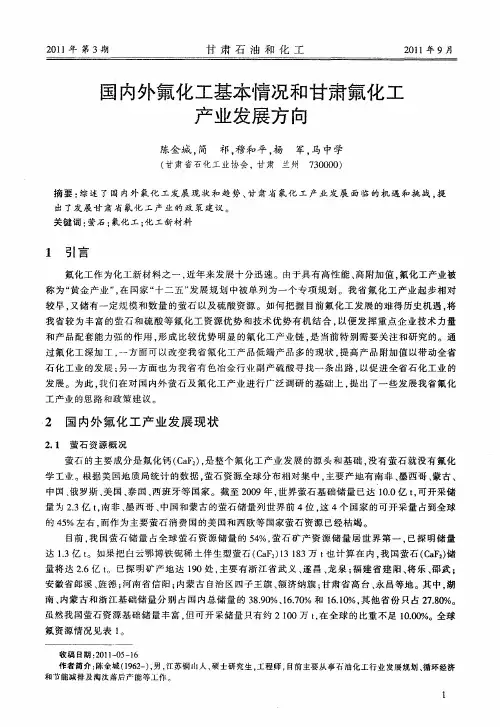
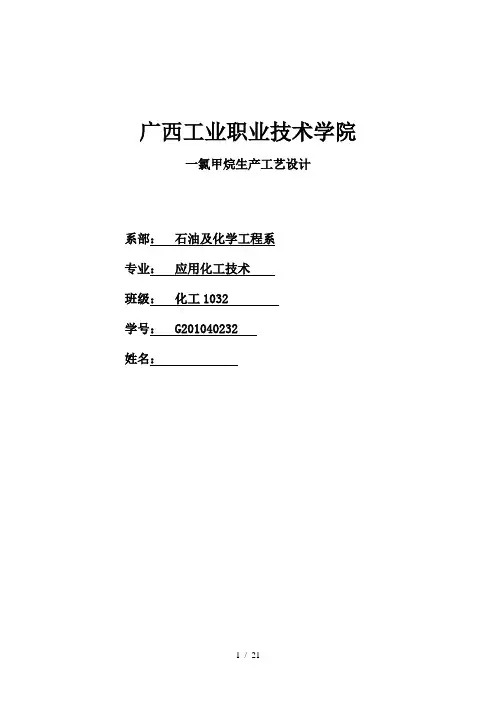
广西工业职业技术学院一氯甲烷生产工艺设计系部:石油及化学工程系专业:应用化工技术班级:化工1032学号: G201040232姓名:前言甲烷氯化物包括一氯甲烷、二氯甲烷、三氯甲烷和四氯化碳,是一类常用的化学制剂,在化工、建材等多个领域有广泛的应用。
其中一氯甲烷还常常作为中间体或者是反应组分应用于多个技术领域,它的重要性和应用的广泛型正在日益的扩大。
作为合成甲基氯硅烷的基础原料,氯甲烷成本占甲基氯硅烷成本的40%,氯甲烷生产的经济模化一直是制约我国有机硅行业发展的关键性技术之一,国内外的生产现状表明我们存在的距离。
随着我国加入WTO,国内有机硅的生产及发展已经面临更加激烈的国际竞争。
如何提高氯甲烷的生产技术水平,尤其是有机硅单体生产企业利用有机硅单体副产盐酸合成氯甲烷进一步提高其工艺技术及装备水平的研究,其意义十分重大。
一氯甲烷的生产方法主要有两种:甲醇氢氯化法和甲烷氯化法。
本设计经过对比国内外各使用的生产方法、经济技术上的分析及根据国内综合情况,最终选择了甲醇氢氯化法的生产方法。
目录第一章一氯甲烷相关介绍第一节一氯甲烷的基本性质第二节一氯甲烷的应用第三节国内外甲烷氯化物的发展概况1.3.1国内1.3. 2国外第二章生产工艺设计第一节生产方法的选择2.1.1气—液相非催化法2.1.2 气—液相催化法2.1.3气—固相催化法第二节甲醇氢氯化法生产原理第三节物料衡算第四节热量衡算2.4.1.进料口2.4.2塔顶2.4.3塔釜第一章一氯甲烷相关介绍第一节一氯甲烷的基本性质外观及性状:无色气体,具有醚样的微甜气味。
主要用途:用作致冷剂、甲基化剂,还用于有机合成。
熔点: -97.7 3沸点: -24.2相对密度(水=1): 0.92相对密度(空气=1): 1.78密度 0.9159g/cm318C时溶解度280ml/水饱和蒸汽压(kPa): 506.62/22℃溶解性:易溶于水、氯仿、丙酮 , 能溶于乙醇等。
![三氯甲烷的概述[文献综述]](https://uimg.taocdn.com/dcf5f5cdf12d2af90242e6ca.webp)
文献综述环境工程三氯甲烷的概述一、前言部分甲烷氯化物包括一氯甲烷、二氯甲烷、三氯甲烷和四氯化碳。
目前国内销售的甲烷氯化物主要是二氯甲烷和三氯甲烷。
三氯甲烷是四种甲烷氯化物的一种,是重要的有机氯产品,在工业上主要用于制造氟里昂(F—22)的原料。
三氯甲烷是优良的有机氯溶剂,能迅速溶解脂肪、油脂和蜡,常用于干洗和工业品的脱脂溶剂的配制。
在粘结剂、食品包装塑料和树脂的调和中用作溶剂。
三氯甲烷在染料、杀蠕虫药、杀真菌剂和烟草苗防霉剂生产中用作中间体。
三氯甲烷作为麻醉剂的应用已停止,但在一些兽药品中仍用作麻醉剂。
在医药工业上的应用有:青霉素,生物碱,淄族化合物,维生素,调味品及葡萄糖等的萃取和提纯中用作溶剂。
它亦可用于痛软膏、祛痰剂、牙膏和排除肠胃剂的配制。
还可用于配制熏蒸清毒剂。
[1]为了保护大气臭氧层,国际上签署了《蒙特利尔议定书》,我国是签约国之一,四氯化碳及其衍生物F-11和F-12均被列为受控物质,行将被禁止使用和生产,美国等发达国家对二氯甲烷和某些领域(如气雾剂,发泡剂)的应用已进行了限制,使世界上甲烷氯化物的生产和消费总量受到一定影响,以三氯甲烷为主要原料的F-22是不受《蒙特利尔议定书》限制的少数品种之一,在我国,F-22作为制冷剂被禁止比发达国家晚十年,随着有机氟材料应用领域的扩大,其消费仍然呈现增长的势头,三氯甲烷的市场需求仍然强劲。
甲烷氯化物中的一氯甲烷主要用作甲基氯硅烷的生产原料,其他用途的市场消费量很小,它的物化性质决定了它的包装特殊性和物流成本。
国内没有单独的一氯甲烷生产装置,一氯甲烷基本上是有机硅生产厂家利用生产甲基氯硅烷副产的氯化氢配套生产的产品和甲烷氯化物生产装置的副产品。
甲烷氯化物的二氯甲烷是优良的有机溶剂,具有很高的溶解能力,沸点低,不燃和毒性很低等特点。
广泛用作溶剂,大量二氯甲烷在安全胶片制造中用作醋酸纤维素的溶剂;三醋酸纤维素抽丝的溶剂和双酚A制造聚碳酸中用作溶剂。
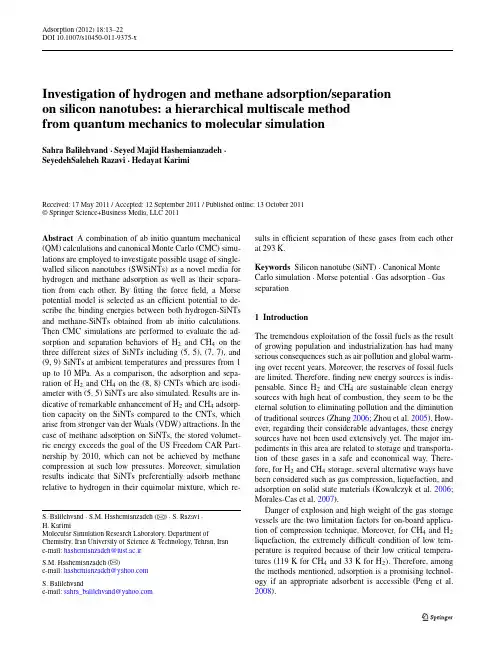
Adsorption(2012)18:13–22DOI10.1007/s10450-011-9375-xInvestigation of hydrogen and methane adsorption/separation on silicon nanotubes:a hierarchical multiscale methodfrom quantum mechanics to molecular simulationSahra Balilehvand·Seyed Majid Hashemianzadeh·SeyedehSaleheh Razavi·Hedayat KarimiReceived:17May2011/Accepted:12September2011/Published online:13October2011©Springer Science+Business Media,LLC2011Abstract A combination of ab initio quantum mechanical (QM)calculations and canonical Monte Carlo(CMC)simu-lations are employed to investigate possible usage of single-walled silicon nanotubes(SWSiNTs)as a novel media for hydrogen and methane adsorption as well as their separa-tion from each other.Byfitting the forcefield,a Morse potential model is selected as an efficient potential to de-scribe the binding energies between both hydrogen-SiNTs and methane-SiNTs obtained from ab initio calculations. Then CMC simulations are performed to evaluate the ad-sorption and separation behaviors of H2and CH4on the three different sizes of SiNTs including(5,5),(7,7),and (9,9)SiNTs at ambient temperatures and pressures from1 up to10MPa.As a comparison,the adsorption and sepa-ration of H2and CH4on the(8,8)CNTs which are isodi-ameter with(5,5)SiNTs are also simulated.Results are in-dicative of remarkable enhancement of H2and CH4adsorp-tion capacity on the SiNTs compared to the CNTs,which arise from stronger van der Waals(VDW)attractions.In the case of methane adsorption on SiNTs,the stored volumet-ric energy exceeds the goal of the US Freedom CAR Part-nership by2010,which can not be achieved by methane compression at such low pressures.Moreover,simulation results indicate that SiNTs preferentially adsorb methane relative to hydrogen in their equimolar mixture,which re-S.Balilehvand·S.M.Hashemianzadeh( )·S.Razavi·H.KarimiMolecular Simulation Research Laboratory,Department of Chemistry,Iran University of Science&Technology,Tehran,Irane-mail:hashemianzadeh@iust.ac.irS.M.Hashemianzadeh( )e-mail:hashemianzadeh@S.Balilehvande-mail:sahra_balilehvand@ sults in efficient separation of these gases from each other at293K.Keywords Silicon nanotube(SiNT)·Canonical Monte Carlo simulation·Morse potential·Gas adsorption·Gas separation1IntroductionThe tremendous exploitation of the fossil fuels as the result of growing population and industrialization has had many serious consequences such as air pollution and global warm-ing over recent years.Moreover,the reserves of fossil fuels are limited.Therefore,finding new energy sources is indis-pensable.Since H2and CH4are sustainable clean energy sources with high heat of combustion,they seem to be the eternal solution to eliminating pollution and the diminution of traditional sources(Zhang2006;Zhou et al.2005).How-ever,regarding their considerable advantages,these energy sources have not been used extensively yet.The major im-pediments in this area are related to storage and transporta-tion of these gases in a safe and economical way.There-fore,for H2and CH4storage,several alternative ways have been considered such as gas compression,liquefaction,and adsorption on solid state materials(Kowalczyk et al.2006; Morales-Cas et al.2007).Danger of explosion and high weight of the gas storage vessels are the two limitation factors for on-board applica-tion of compression technique.Moreover,for CH4and H2 liquefaction,the extremely difficult condition of low tem-perature is required because of their low critical tempera-tures(119K for CH4and33K for H2).Therefore,among the methods mentioned,adsorption is a promising technol-ogy if an appropriate adsorbent is accessible(Peng et al. 2008).The separation of hydrogen and methane from each other is another issue that is of crucial importance,since95%of hydrogen used in the fuel cells is provided by the purifica-tion of synthetic gas obtained from steam reforming of nat-ural gas(Kowalczyk et al.2007).For more than two decades,a large variety of porous ma-terials for instance carbon nanotubes(Tanaka et al.2005; Poirier et al.2006;Chen and Sholl2006),fibers and acti-vated carbon(Dillon et al.1997;Bhatia and Myers2006), molecular sieves(Ohkubo et al.2002;Roussel et al.2006), layered pillared pore materials(Cao et al.2002),and metal organic frameworks(MOFs)(Li and Yang2005,2006) have been explored tofind efficient adsorbent for H2and CH4storage,and their separation from each other.Car-bon nanotubes have particularly attracted a great deal of attention because of their unique properties.Bekyarove et al.(2003)have reported measurement of methane ad-sorption on single-walled carbon nanotube(SWCNTs).In 2004,Lan et al.(2008)performed grand canonical Monte Carlo simulation(GCMC)to optimize the SWNT arrays for methane storage,and their simulation results demonstrated that methane storage in the optimized triangular arrays at 4.1MPa exceeded the US Department of Energy(DOE) goal.Lee et al.(2006)have measured the methane adsorp-tion on multi-walled carbon nanotubes(MWCNTs)com-pared to two types of zeolites(DAY and HSZ-320).Their experimental data indicated that the methane uptakes of MWCNTs were higher than for zeolites.Kowalczyk et al. (2006)have investigated methane storage on bundles of (10,10)CNTs and worm-like carbon porous by GCMC sim-ulation.Their results have revealed that such nanoscale ma-terials can attain the US freedom CARP partnership goal at ambient temperature.Many studies have also been accomplished about hydro-gen adsorption on pristine and improved doped carbon nan-otubes.However,most of these efforts have failed to attain the DOE target,namely6.5wt%by2010.Nowadays,most of the researchers believe that the solution to this problem comes from the design of novel materials(Cote et al.2005; Rosi et al.2003;Yaghi et al.2003;Mpourmpakis et al. 2006).Recently,silicon nanotubes(SiNTs)have been syn-thesized by several methods such as the chemical vapor de-position(CVD)(Sha et al.2002)and hydrothermal(Chen et al.2005;Tang et al.2005)methods.Silicon is more po-larizable than carbon due to the presence of more electrons in its outer shells.Therefore,we anticipate that SiNTs can be tailored to achieve a stronger van der Waals attraction to adsorbed molecules than CNTs(Lan et al.2008).Only a few studies have been implemented about hydrogen ad-sorption on SiNTs(Lan et al.2008;Lithoxoos et al.2008; Ryou et al.2008).Lan et al.(2008)have used multiscale the-oretical method,combining thefirst-principle calculations and a grand canonical Monte Carlo(GCMC)simulation to evaluate the hydrogen adsorption on the SiNT arrays.They have found that capacity of hydrogen adsorption on SiNT ar-rays is considerably higher than that on CNTs and SiCNTs.In the current study,we employed a multiscale theoreti-cal approach to explore the hydrogen and methane adsorp-tion on SiNTs as well as their separation from each other. First the binding energies between adsorbate and adsorbent obtained from ab initio calculations werefitted to a proper potential function.Then the results were applied as an input in the canonical Monte Carlo(CMC)simulation to evalu-ate capacity of adsorption of hydrogen,methane,and their equimolar mixture on SiNTs at different pressures,tempera-tures,and tube sizes.The amount of H2and CH4adsorption on SiNTs and CNTs were also stly,the pos-sibility of H2–CH4separation by SiNTs was considered at 293K.2Models and methodology2.1Ab initio calculationsIn this section,for the determination of the interaction po-tential of CH4and H2with SiNTs,ab initio calculations were carried out using the Gaussian03program package.Three different sizes of armchair-type SiNTs including (5,5),(7,7),(9,9)SiNTs were adopted as adsorbents,due to survey of curvature effect on the adsorption behavior of species.In this work,to obtain results with high accuracy, without executing heavy calculations,the SiNTs were char-acterized by cluster model,since adsorbed molecules mainly interact with their closest atoms in the adsorbent(Mpourm-pakis et al.2006;Lan et al.2008).According to the diam-eter of the tubes,two cluster models were used in thefirst-principle calculation.As shown in Fig.1,the cylinder clus-ter model containing70Si atoms was chosen for the(5,5) SiNT,because of its small diameter,whereas,for both(7,7) and(9,9)SiNTs,a graphite like sheet constituting24Si atoms were selected,due to their bigger diameters and lower curvatures.In addition,to avoid the edge effect,all the dan-gling bonds at the ends of the tubes were terminated by hy-drogen atoms(Mpourmpakis et al.2006;Meng et al.2007). In all the selected cluster models of nanotubes,three adsorp-tion sites were considered:on-top,bridge,and hollow(Lan et al.2008).Tofind the energetically favorable site for H2 and CH4adsorption,the binding energies were calculated in the mentioned positions,by DFT/MP1PW91method,which could afford more accurate results than DFT/B3LYP for dis-persion force(Mpourmpakis et al.2006;Lan et al.2008). Additionally,to attain the highest possible accuracy,for hy-drogen,methane and their closest six silicon atoms,the 6-311++g∗∗basis set was used,while for the other atoms, the3-21g basis set was treated(Mpourmpakis et al.2006;Fig.1Top and sideview of the SiNT cluster models where dangling bond at the end of tubes are saturated by hydrogen atoms:(a)(9,9) SiNT and(b)(5,5)SiNTLan et al.2008).Our results indicate that the hollow sites are the most favorable adsorption sites for both H2and CH4.It should be mentioned that similar results have also been ob-tained for adsorption of hydrogen on SiNTs by Lan et al. (2008).According to the results obtained from geometry opti-mization,the hollow sites were considered to perform poten-tial energy surface scans.Many different orientations were possible when H2and CH4approached the hollow sites of the SiNTs.The most important orientations and correspond-ing potential energy curves for both hydrogen and methane adsorption on the hollow sites are illustrated in Figs.2and3.It is worthy to point out that a similar vertical orientation has also been observed for hydrogen adsorption on SiCNTs and CNTs(Mpourmpakis et al.2006).By inspecting carefully the curves shown in Fig.3,we find that for both hydrogen and methane,increase in nan-otube diameter results in decrease in binding energy.This has explicitly been attributed to the curvature effect(Kleiner and Eggert2001).Additionally,since the interaction en-ergies for interaction of CH4and H2with SiNTs are in the region of physisorption through the van der Waals in-teractions,and CH4is more polarizable than H2,stronger CH4–SiNT interactions are resulted.2.2Choice of an accurate potential equationTo employ the results obtained by ab initio calculations in the simulation of hydrogen and methane adsorptionon Fig.2The energetically favorable orientations for hydrogen and methane adsorption on the(7,7)SiNT:(a)hydrogen adsorption and (b)methane adsorptionSiNTs,we require to choose a potential function as a link between ab initio calculations and canonical Monte Carlo simulations.The proper choice of this function is of cru-cial importance,because the accuracy of the simulation re-sults is influenced by this choice.Therefore,three models of potential functions including(12-6)and(9-6)Lennard–Jones(LJ)and Morse equations were selected to describe the potential curves obtained from thefirst-principle calcu-lations.Neither(12-6)LJ nor(9-6)LJ equation could befitted with the H2and CH4potential curves,because the slope of repulsion branch in LJ potentials is sharper than that in the potential curves from ab initio calculations,whereas we found that the Morse potential in(1)is in excellent coinci-dence with the results driven from the ab initio calculations for both hydrogen and methane,due to slower slope in the repulsion branch.The Morse potential is represented as fol-lows(Lan et al.2008):U i=2D[X2−2X],X=exp−g2r ir e−1(1)where r i is center to center distance(Å).For hydrogen and methane,the Morse potential parameters are listed in Ta-ble1.All the calculations have already been reported for ad-sorption of hydrogen on the surface of silicon nanotubes by Lan et al.(2008).It should be noted that ourfindings are consistent with their results.2.3Canonical Monte Carlo (CMC)simulationA standard CMC simulation was carried out to investi-gate the adsorption of pure hydrogen and methane,and their mixture on SiNTs at different pressures,tempera-tures,and tube diameters.In this method,the standard procedure Metropolis sampling was applied for the ac-ceptance decision of every configuration generated by the random displacement of a molecule from former config-uration.For each isotherm point,5×107configurations were generated.The system was achieved toequilibrateFig.3Potential energy curves of H 2and CH 4adsorption on three dif-ferent sizes of SiNTs with favorable orientation approaching the hol-low sites:(a )methane adsorption (b )hydrogen adsorptionafter 2×107steps,and the remaining 3×107configu-rations were used to obtain ensemble average values for thermodynamic properties.The periodic boundary condi-tion was imposed in the all three dimensions (Lan et al.2008).The intermolecular interactions between H 2–H 2and CH 4–CH 4were calculated using the (12-6)LJ potential (Lan et al.2008;Heyden et al.2002)φLJ (r)=4εffσff r12−σff r 6.(2)Here r is the distance between two interacting fluid molecules,σff denotes the LJ fluid–fluid collision diame-ter in the unit of nm,and εff is the LJ fluid–fluid potential well depth in the unit of K .Additionally,Lorentz–Berthelot combining rules in (3)were applied for the interaction be-tween H 2and CH 4as well as the interaction of H 2and CH 4with (8,8)CNT εij =√εi εj ,σij =12(σi +σj ).(3)The Lennard–Jones parameters for each species are listed in Table 2.The total interactions between adsorbed molecules and SWSiNTs were represented using the Morse potential equa-tion,which was introduced before.In the CMC simulation,the temperature,the volume of simulation box,and the number of molecules are held con-stant during the simulation of every state.In this work,the simulation box (100Å×100Å×45Å)contains one single-walled nanotube with the length of about 37Åat its center along with z -axis.The Virial equation of state with second and third viral coefficients was applied to estimate the num-ber of fluid molecules at different temperatures and pres-Table 2Lennard–Jones parameters used in the simulations (Lan et al.2008;Heyden et al.2002)Species ε/k B (K)σ(A)H 2–H 242.8 2.97CH 4–CH 4148.1 3.81C–C283.4Table 1The Morse potential parameters used to describe the interactions of H 2and CH 4with the hollow sites of the SiNTsInteraction energies between gases and outside the tube walls Morse potential parameterFor (9,9)SiNT For (7,7)SiNT For (5,5)SiNT H 2CH 4H 2CH 4H 2CH 4D (kcal/mol) 1.1 2.9510.983 2.6030.973 2.548g 4.83 5.71 4.768 5.703 4.98 5.818r e (A)2.793.6082.983.6472.9443.744Table3Coefficients of temperature correlation for pure-component second Virial coefficients(Estela-Uribe et al.2003)Interaction b ij0×10−2b ij1b ij2(dm3mol−1)(dm3Kmol−1)(dm3K2mol−1) CH4–CH4 4.218856−1.713109×101−2.457425×103 H2–H2 2.083580−1.928868−1.065080Table4Coefficients of temperature correlation for pure-component third Virial coefficients(Estela-Uribe et al.2003)Interaction c ij0c ij1c ij2(dm6mol−2)(dm6K mol−2)(dm6K2mol−2) CH4–CH4–2.799668×10−3−9.276054×10−12.446528×102 CH4H2–H2–H21.597000×10−46.427210×10−2−1.254470×10−1 sures to achieve more accurate results than usage ideal gas equationP VNRT=1+B (T)P+C (T)P2,B =BRT,C =(C−B2)(RT)2,(4)where B and C are the second and third Virial coefficients, respectively,which are functions of temperature and type of species.Virial coefficients were determined through follow-ing relations reported by J.F.Estela-Uribe et al.(2003)B ij=b ij,0+b ij,1T+b ij,2T,(5)C ijk=c ijk,0+c ijk,1T+c ijk,2T.(6)The amounts of the coefficients in(5)and(6)for pure H2and CH4are listed in Tables3and4(Estela-Uribe et al. 2003).Furthermore,temperature and type of molecule,for the mixture of gases B and C,are also dependent on the bulk composition through the following relations:B MIX=ijx i x j B ij,(7)C MIX=ijkx i x j x k C ijk.(8)In(7)and(8),x i,x j,and x k are the mole fractions of the i th,j th,and k th components of the mixture.B ij and C ijk are also obtained by(5)and(6),and the corresponding parameters are listed in Tables5and6(Estela-Uribe et al. 2003).Table5Coefficients of temperature correlation for interaction second Virial coefficientsfitted to binary-mixture compression factors(Estela-Uribe et al.2003)Interaction b ij0×10−2b ij1b ij2×101(dm3mol−1)(dm3K mol−1)(dm3K2mol−1) CH4–H2 3.733621−9.050586−5.118172Table6Coefficients of temperature correlation for independent double-interaction third Virial coefficientsfitted to binary-mixture compression factors(Estela-Uribe et al.2003)Interaction c ij0×10−4c ij1×10−1c ij2(dm6mol−2)(dm6K mol−2)(dm6K2mol−2)CH4–CH4–H2 2.894530 2.0820701.959194×101 CH4–H2–H2 2.608140 1.182288 1.565030Furthermore,to obtain adsorption isotherms,gravimetric storage capacity(pw)was calculated using following equa-tion:ρW=N gas.m gasN gas.m gas si.m si.(9)Here,N gas and N Si are the number of adsorbed molecules and nanotube atoms,respectively.In addition,the heat of combustion was used to eval-uate the volumetric energy storage;the corresponding values for methane and hydrogen are−55.6MJ/kg and −141.789MJ/kg,respectively(Kowalczyk et al.2007).3Results and discussion3.1Adsorption of pure H2and CH4on SiNTsThe adsorption behaviors of CH4and H2on three differ-ent sizes of SiNTs including(5,5),(7,7),and(9,9)SiNTs were investigated at two supercritical temperatures(293K, 313K)and pressures ranging from1up to10MPa.Our simulation results in Fig.4reveal that for hydrogen and methane adsorption,the gravimetric storage capacity is an increasing function of pressures and decreasing func-tion of temperatures.As expected,in all the simulations, the amount of CH4adsorption capacity is greater than H2, due to its stronger interaction with SiNTs and higher boiling temperature.The effect of tube size on the adsorption capacity was also investigated.As mentioned above,we perceived from the ab initio calculations that the potential interaction of fluids with SiNTs increase palpably for both hydrogen and methane adsorption,while the diameter declines.However,Fig.4Gravimetric adsorption isotherms for adsorption of H2and CH4on the(5,5),(7,7),and(9,9)SiNTs at293K and313K,andfive pressures:(a)H2adsorption at293K(b)H2adsorption at313K(c)CH4adsorption at293K(d)CH4adsorption at313Kour CMC simulation results in Fig.4indicate that among the three different sizes of silicon nanotubes,the(7,7)and(9, 9)SiNTs provide the highest storage capacity for both H2 and CH4within the pressure range under study.This incon-sistency emanate from the fact the amount of gas adsorption is influenced by several factors such as the space,surface area,and attractive force.The co-effect of these factors de-termines the magnitude offluid adsorption on the SiNTs(Gu et al.2002).The smaller space and surface area of the(5,5)SiNTs overwhelm the higher potential interaction of CH4and H2 with this sorbent.Therefore,over the pressure range under study,the(5,5)SiNT exhibits the lowest gravimetric storage capacity for both H2and CH4compared to(7,7)and(9,9) SiNTs.3.2Comparison of H2and CH4adsorption on the SiNTsand CNTsFigure5depicts the gravimetric storage capacity for H2and CH4adsorption on the(5,5)SiNTs and isodiameter(8,8) CNTs as a function of pressure at293K.All the hydrogen and methane adsorption isotherms are characterized by type 1(Langmuir shape),and no capillary condensation is ob-served.As we can see from thisfigure,due to stronger interac-tion between the SiNTs andfluids,the values of hydrogen and methane adsorption on the(5,5)SiNTs are consider-ably higher than those on the isodiameter(8,8)CNTs.The gravimetric percentage enhancement for both H2and CH4 are presented in Table7.Fig.5Gravimetric storage capacity for adsorption of H2and CH4on the(5,5)SiNTs compared to isodiameter(8,8)CNTs at293K and pressure range from1to10MPa:(a)H2gravimetric capacity and(b) CH4gravimetric capacityMoreover,the adsorption isotherms for hydrogen and methane do not show saturation.Therefore,higher adsorp-tion capacity for both H2and CH4is expected by further increase in pressure(Li and Yang2005).Additionally,in-crease in pressure results in increase in repulsion force.Be-cause,in contrary to the LJ potential applied to describe gas adsorption on the CNTs,the Mors potential rises smoothly at repulsion branch,the enhancement rate of gas adsorption on the SiNTs is greater than that in the CNTs at elevated pressures.Therefore,we can conclude that the SiNTs are a promising candidate for hydrogen storage to achieve the DOE target(Lan et al.2008).Moreover,in order to answer the question,whether SiNTs are appropriate media for methane adsorption,the Table7Gravimetric percentage enhancement of H2and CH4adsorp-tion on the(5,5)SiNTs compared to(8,8)CNTs at293KAdsorbed1MPa3MPa5MPa7MPa10MPa moleculesCH4101%73%53%47%45%H295%74%60%59%57% Fig.6The variation of stored volumetric energy for adsorption of methane on the(5,5),(7,7),and(9,9)SiNTs as well as(8,8)CNTs with pressure at298K.Solid line indicates the US Freedom CAR Part-nership goal(5.4MJ/dm3)stored volumetric energy for adsorption of methane on the SiNTs has been presented in Fig.6.The methanefluid requires to be compressed to approx-imately13MPa at293K,to provide the2010target for volumetric energy storage(5.4MJ/dm3)(Kowalczyk et al. 2006),whereas all the three silicon nanotubes investigated in this work achieved this goal at much lower pressures.Fur-thermore,since the interaction energies of methane with the SiNTs are in the region of physisorption,captured methane can simply be liberated by variation of the temperature. Therefore,we can conclude that silicon nanotubes are ex-cellent materials for methane storage at ambient temper-atures.In comparison with the(5,5)SiNTs,isodiameter (8,8)CNTs can not provide the2010target over the pres-sure range under study.3.3Adsorption of CH4and H2mixture on the SiNTsFor all considered SiNTs,the gravimetric storage capacity of two components of equimolar CH4–H2mixture is illus-trated in Fig.7.The temperature was set at293K.As we can observe,the variation patterns of H2and CH4adsorption onFig.7Pressure variation of gravimetric adsorption isotherms of hy-drogen and methane in the equimolar CH4–H2mixture at293K:(a) hydrogen isotherms and(b)methane isothermsbinary mixture with pressure and temperature is similar to their pure adsorption.Additionally,it is clear from Fig.8that the amount of vol-umetric energy stored by adsorption of equimolar CH4–H2 mixture on the SiNTs is much higher than that by bulk compression.Furthermore,the stored volumetric energy of equimolar mixture for adsorption on the(9,9)SiNTs at 10MPa is very close to the US Freedom CAR Partnership goal by2010.3.4SelectivityThe discrepancies between the adsorption behaviors for ad-sorption of CH4and H2molecules on the SiNTs manifest-ing these sorbents are effective for separation of CH4and H2from eachother.Fig.8The stored volumetric energy of equimolar H2–CH4mixture in the different sizes of SiNTs versus storage pressure at293K.Solid line corresponds to the2010target of the US Freedom CAR Partnership (5.4MJ/dm3)and dashed line corresponds to the volumetric energy of H2–CH4compression in the equimolarmixtureFig.9The variation of equilibrium selectivity of methane over hydro-gen in the(5,5),(7,7),and(9,9)SiNTs with pressureTo provide deep insight into the separation efficiency of silicon nanotubes,we can explain the equilibrium selectivity of CH4over H2as follows(Morales-Cas et al.2007):S CH4,H2=(x CH4/x H2)pore(y CH4/y H2)bulk(10)where x and y refer to the mole fractions of species at adsor-bent and bulk phases,respectively.It is worthy to point out that if the selectivity is larger than unity,methane is prefer-entially adsorbed compared to hydrogen.In this section we consider,how pressure and tube diam-eter exert their affects on the selectivity of CH4over H2in the equimolar mixture and at293K.Figure9displays the equilibrium selectivity for CH4over H2storage on the SiNTs versus storage pressure.Obviously,Fig.10The equilibrium selectivity of methane over hydrogen in the (5,5)SiNTs and(8,8)CNTsthe equilibrium selectivity diminishes as the pressure in-creases.This phenomenon is attributed to the packing effect which becomes dominant at elevated pressures.Therefore, in these conditions,the smaller molecules are more proper to be packed in the nanotubes(Gu et al.2002).In addition,the value of the selectivity mostly is influ-enced by the potential interaction betweenfluids and SiNTs (Huang et al.2007).Since the interaction energy of CH4and H2with SiNTs come nearer to each other with increase in the tube diameter,the(9,9)SiNT indicates the lowest value of equilibrium selectivity.The variation of selectivity with pressure in the(5,5) SiNTs compared to the isodiameter(8,8)CNTs was also presented in Fig.10.The results show that the(8,8)SiNT is more favorable than the(8,8)CNT for separation of CH4 and H2from each other.It is worthy to point out that in all the cases,the selec-tivity of CH4over H2is higher than unity.Therefore,the separation of these gases is possible under the investigated conditions.4ConclusionsIn summary,the performance of silicon nanotubes as a novel material for pure and mixed H2and CH4adsorption as well as their separation in the equimolar mixture were studied using a multiscale theoretical approach.The interaction en-ergies of hydrogen and methane with the SiNTs determined via ab initio calculations werefitted to a Morse potential equation employed as an input in the canonical Monte Carlo simulations.To investigate the effects of size,temperature, and pressure on the adsorption and separation behaviour of hydrogen and methane,three different-sized silicon nan-otubes including(5,5),(7,7),and(9,9)SiNTs,two tem-peratures(293and313K),andfive pressures in the range from1to10MPa were considered.In all the investigated conditions,the adsorption capacities for adsorption of both H2and CH4on the SiNTs are increasing function of pres-sure and decreasing function of temperature.Additionally, simulation results indicate that higher adsorption capacity for both H2and CH4are provided by SiNTs compared to CNTs.This phenomenon arises from the fact that electronic cloud around the surface of silicon nanotube is denser than that around the CNT,which results in stronger VDW attrac-tion to the gases.As an excellent result from this research, in all three sizes of SiNTs,the amount of energy stored by CH4adsorption exceeds the target of the US Freedom CAR Partnership by2010at293K and low pressures from 3to4.5MPa.This target can not be achieved by methane compression at such low pressures.Moreover,the interac-tion energies of methane with the SiNTs are in the regain of physisorption.Therefore,liberation of methane can be con-trolled by simple variation in the temperature.Accordingly, we can conclude that the SiNTs are appropriate materials for methane storage.Furthermore,the stored volumetric energy of equimolar mixture in the(9,9)SiNT at10MPa is very close to the US Freedom CAR Partnership target.Moreover,the possible usage of silicon nanotubes as an efficient media for separation of hydrogen and methane in the equimolar mixture were explored at293K and pres-sure range from1to10MPa.The results indicate that the selectivity is a decreasing function of pressure because the packing effect is principle at higher pressures.Regarding the amounts of selectivity of methane over hydrogen,we can conclude that although all three investigated SiNTs are suit-able medias for H2and CH4separation,the(5,5)SiNT is the best one,in which the selectivity varies from2.5to4.2 at the pressure range under study.ReferencesBekyarova,E.,Murata,K.,Yudasaka,M.,Kasuya,D.,Iijima,S., Tanaka,H.,Kahoh,H.,Kaneko,K.:Single-wall nanostructured carbon for methane storage.J.Phys.Chem.B107,4681–4684 (2003)Bhatia,S.K.,Myers,A.L.:Optimum conditions for adsorptive storage.Langmuir22,1688–1700(2006)Cao,D.,Wang,W.,Duan,X.:Grand canonical Monte Carlo simulation for determination of optimum parameters for adsorption of super-critical methane in pillared layered pores.J.Colloid Interface Sci.254,1–7(2002)Cao,D.,Zhang,X.,Chen,J.,Wang,W.,Yun,J.:Optimization of single-walled carbon nanotube arrays for methane storage at room temperature.J.Phys.Chem.B107,13286–13292(2003) Chen,H.,Sholl,D.S.:Predictions of selectivity andflux for CH4/H2 separations using single walled carbon nanotubes as membranes.J.Membr.Sci.269,152–160(2006)。

耗碱耗氯产品介绍一、氯乙酸产品性质:氯乙酸又名一氯醋酸,分子式CHClO,其是双官能团化合物,232为无色或淡黄色结晶,有刺激性气味,沸点(760mmHg)-188?,折射率1.4330(60?),熔点:61,63?,有腐蚀性,水溶液呈酸性反应。
氯乙酸易潮解,易溶于水、醇、苯、氯仿和醚等。
在25?水100g时溶解度为510g,在100g甲醇中溶解度为350g。
氯乙酸有刺激性臭味,为二级酸性腐蚀物品,大鼠经口LD50为76mg/Hg,豚鼠经口LD为80mg/Hg。
应用领域:氯乙酸在农药、医药、染料、日化、表面活性剂、化学试剂以及造纸化学品、油田化学、纺织助剂橡胶助剂、电镀、香料香精等方面具有广泛的应用。
全球氯乙酸主要用于生产羧甲基纤维素(CMC)、PVC热稳定剂巯基乙酸、2,4-氯苯氧基乙酸(2,4-D)等。
我国氯乙酸的主要消费领域是农药、农药工业,氯乙酸可以合成20余种常用的杀虫、除草和植物生产调节剂,其中消耗氯乙酸量最大的品种为全球范围内使用的主流除草剂草甘磷。
消耗定额:原料及动力主要消耗(以1吨氯乙酸计)名称规格消耗量醋酸 ?98% 0.597t醋酐 ?98% 0.069t液氯 ?99.5% 0.809t水 - 125t电 - 320kW.h汽 - 2.1t生产企业:目前中国和西欧已经成为全球最主要的氯乙酸生产地区和国家。
国内主要氯乙酸生产企业有阿克苏诺贝尔氯乙酸化工(泰兴)有限公司、江苏无锡格林艾普化工股份有限公司、河南开封东大化工集团有限公司、河北省石家庄合成化工厂、山东华阳集团、大连朗迪森化学有限公司等。
行业现状:我国氯乙酸生产起步较晚,直到20世纪80年代中期,随着我国石油工业的发展,钻井用助剂羧甲基纤维素用量大幅度上升,我国氯乙酸的生产才开始得到发展。
90年代初我国农药除草剂的迅猛发展,又一次刺激了氯乙酸工业的发展,在此间我国相继建设了多套氯乙酸生产装置。
1991年7月,江苏东台市有机合成化工厂采用乙酸酐作催化剂的500吨/年氯乙酸生产装置建成投产,开创了我国乙酸氯化法生产氯乙酸的先例。
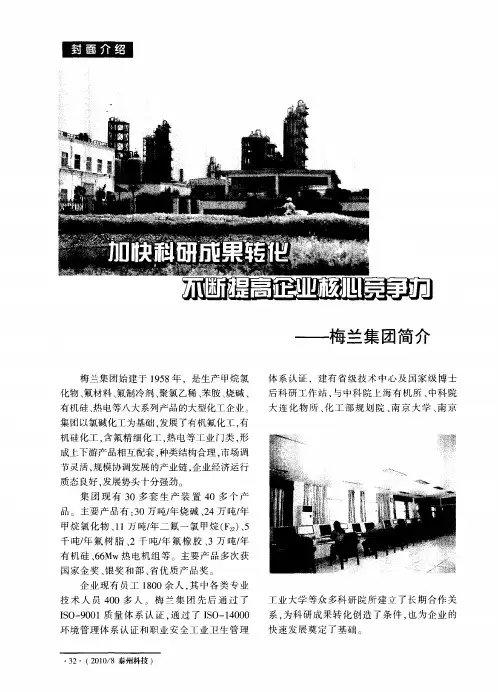
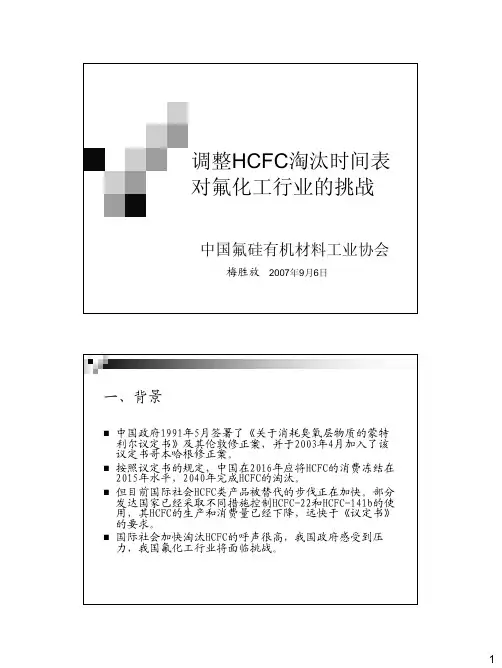
调整HCFC淘汰时间表对氟化工行业的挑战中国氟硅有机材料工业协会梅胜放2007年9月6日一、背景中国政府1991年5月签署了《关于消耗臭氧层物质的蒙特利尔议定书》及其伦敦修正案,并于2003年4月加入了该议定书哥本哈根修正案。
按照议定书的规定,中国在2016年应将HCFC的消费冻结在2015年水平,2040年完成HCFC的淘汰。
但目前国际社会HCFC类产品被替代的步伐正在加快。
部分发达国家已经采取不同措施控制HCFC-22和HCFC-141b的使用,其HCFC的生产和消费量已经下降,远快于《议定书》的要求。
国际社会加快淘汰HCFC的呼声很高,我国政府感受到压力,我国氟化工行业将面临挑战。
2007年系列会议,探讨HCFCs的淘汰问题 2006年10月缔约方大会期间,发达国家成立了有关组织,探讨提前淘汰HCFCs的可能性。
9个国家提出6个加速淘汰HCFCs的提案。
保护臭氧层公约秘书处、多边基金秘书处以及欧盟2007年也已经开了一系列会议,探讨HCFCs的淘汰问题。
二、中国HCFC生产和消费情况我国生产和使用较多的HCFC包括HCFC-22,HCFC-14lb,HCFC-142b,HCFC-123,HCFC-124,HCFC-133等六种。
2005年我国0DS生产量约28.4万吨,0DS消费量约17.6万吨。
2006年我国HCFC 生产和消费数据比2005年增长分别高达21%和33%。
其中,HCFC-22约占整个HCFC总量的70%,HCFC-141b约占21%,HCFC-142b约占6.5%,这三类物质总比例约98%左右。
中国HCFC生产和消费数据(0DP)┏━━━━━━┳━━━┳━━━┳━━━┳━━┳━━━┳━━━┳━━━┓┃类别┃1999 ┃2000 ┃2001 ┃2002┃2003 ┃2004 ┃2005 ┃┣━━━━━━╋━━━╋━━━╋━━━╋━━╋━━━╋━━━╋━━━┫┃生产量┃4044 ┃5940 ┃7022 ┃8651┃11745┃15447 ┃18022 ┃┣━━━━━━╋━━━╋━━━╋━━━╋━━╋━━━╋━━━╋━━━┫┃消费量┃3612 ┃5166 ┃5126 ┃5789┃7809 ┃10380 ┃11591┃┗━━━━━━┻━━━┻━━━┻━━━┻━━┻━━━┻━━━┻━━━┛数据显示,中国HCFC从1999年—2005年7年间生产增长了3.5倍,年增长率平均约28%;消费增长了3.2倍,年增长率约22%;出口年增长率约61%。

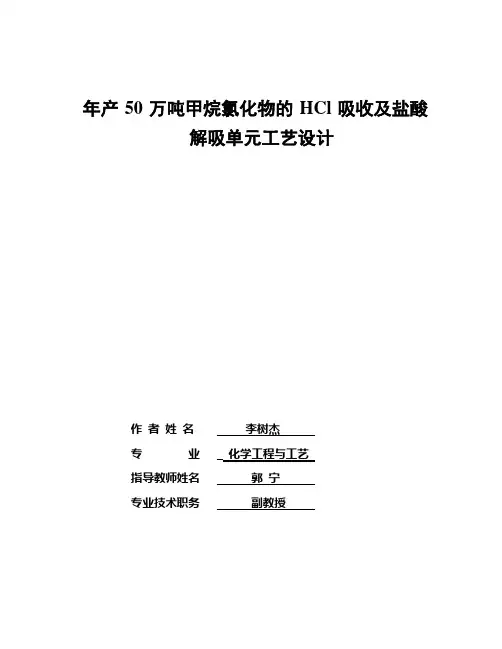
年产50万吨甲烷氯化物的HCl吸收及盐酸解吸单元工艺设计作者姓名李树杰专业化学工程与工艺指导教师姓名郭宁专业技术职务副教授目录摘要 (1)第一章项目背景简介 (3)1.1甲烷氯化物简介 (3)1.2甲烷氯化物生产方法简介 (3)1.3产品的市场需求状况 (4)1.3.1一氯甲烷的市场需求 (4)1.3.2 二氯甲烷的市场需求 (5)1.3.2三氯甲烷的市场需求 (5)第二章生产方案的确定 (6)2.1生产规模 (6)2.2原料路线确定的原则和依据 (7)2.3氯甲烷的生产方法 (7)2.3.1生产原理 (7)2.3.2工艺流程 (7)2.4工艺技术方案的选择 (9)第三章生产工艺流程介绍 (10)3.1工艺流程说明 (10)3.1.1工艺原理及工艺流程简述 (10)第四章工艺计算书 (11)4.1物料衡算 (11)4.1.1对整个工艺流程进行物料计算 (11)4.1.2对HCl吸收及盐酸解吸单元物料衡算 (13)4.2热量衡算 (15)4.2.1对HCl吸收及盐酸解吸单元能量衡算 (17)第五章主要设备的工艺计算及选型 (18)5.1汽提塔的设计及选型 (18)5.1.1筒体厚度计算 (18)5.1.2封头厚度计算 (19)5.1.3塔体高度计算 (19)5.1.4塔体上各项载荷计算 (20)5.2主要设备一览表 (22)第六章原材料、动力消耗定额及消耗量 (24)6.1原材料、辅助材料消耗定额及消耗量 (24)6.2公用工程消耗量 (25)第七章环境保护与安全措施 (25)7.1本装置的主要环境污染源及主要污染物 (25)7.1.1废水 (25)7.1.2废气 (26)7.1.3固体废物 (26)7.1.4噪声 (27)7.2环境污染及污染防治措施 (27)7.2.1水污染防治措施 (27)7.2.2大气污染防治措施方案 (27)7.2.3固体废弃物处置措施方案 (28)7.2.4噪声防治措施 (28)7.2.5其他环境保护措施 (28)第八章车间成本估算 (29)第九章设计体会和收获 (29)参考文献 (30)致谢 (31)摘要本设计主要是对50万吨甲烷氯化物生产项目的设计。
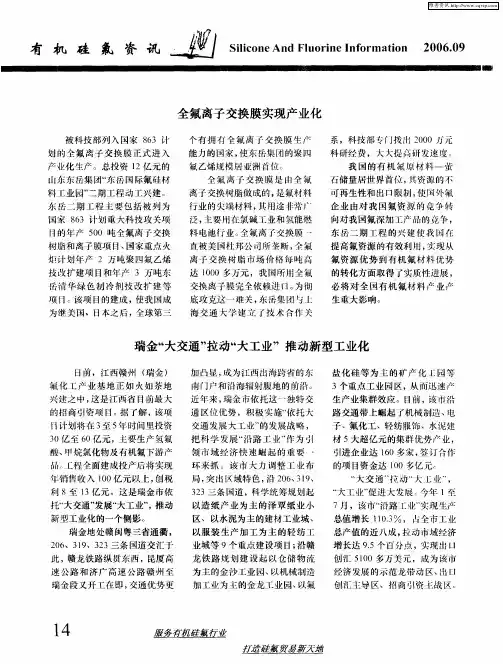
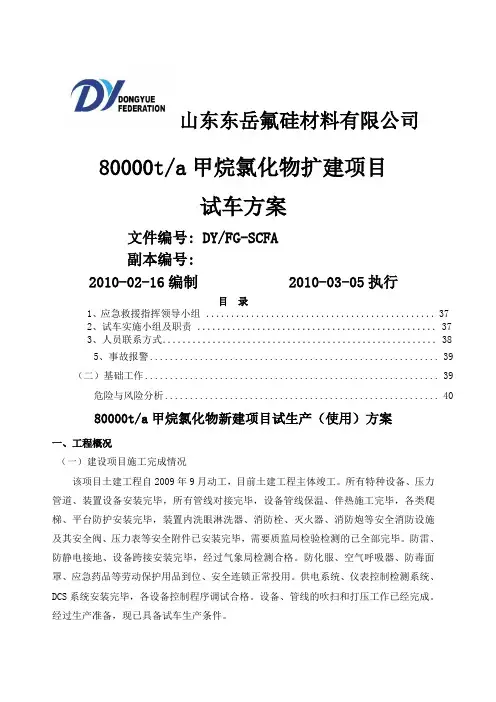
山东东岳氟硅材料有限公司80000t/a甲烷氯化物扩建项目试车方案文件编号: DY/FG-SCFA副本编号:2010-02-16编制 2010-03-05执行目录1、应急救援指挥领导小组..............................................372、试车实施小组及职责................................................373、人员联系方式.......................................................385、事故报警 (39)(二)基础工作 (39)危险与风险分析 (40)80000t/a甲烷氯化物新建项目试生产(使用)方案一、工程概况(一)建设项目施工完成情况该项目土建工程自2009年9月动工,目前土建工程主体竣工。
所有特种设备、压力管道、装置设备安装完毕,所有管线对接完毕,设备管线保温、伴热施工完毕,各类爬梯、平台防护安装完毕,装置内洗眼淋洗器、消防栓、灭火器、消防炮等安全消防设施及其安全阀、压力表等安全附件已安装完毕,需要质监局检验检测的已全部完毕。
防雷、防静电接地、设备跨接安装完毕,经过气象局检测合格。
防化服、空气呼吸器、防毒面罩、应急药品等劳动保护用品到位、安全连锁正常投用。
供电系统、仪表控制检测系统、DCS系统安装完毕,各设备控制程序调试合格。
设备、管线的吹扫和打压工作已经完成。
经过生产准备,现已具备试车生产条件。
(二)项目简介甲烷氯化物项目产品包括一氯甲烷、二氯甲烷、三氯甲烷、四氯化碳。
随着中国加入WTO和《蒙特利尔议定书》规定的发达国家CFC、HCFC生产的关停或削减,为我国氟制冷剂R22的发展创造了难得的发展机会,带动了其原料三氯甲烷的市场需求。
公司作为全国最大的R22的生产企业,是三氯甲烷需求的最大用户。
为此,公司申请申报80000吨/年甲烷氯化物建设项目,以满足企业发展的需求。
经营管理层面上改革创新的成功范例Ting Bao was revised on January 6, 20021内部资料注意保存加大力度推进四川油气化工产业发展的研究223四川省科技顾问团办公室编二○○八年十二月加大力度推进四川油气化工产业发展的研究《专题研究报告》223期反馈意见:回函请寄:成都市人民南路四段11号七楼省科技顾问团办公室邮政编码:610041E-mail课题组成员名单顾问:辛文四川省科学技术顾问团副主任教授组长:刘资甫四川省科学技术顾问团顾问四川省工程咨询研究院专家委员会主任教授级高工成员:俞长昌成达工程公司原副总工程师教授级高工周正明西南化工研究设计院总工程师教授级高工芶莹四川省科学技术顾问团工业经济组兼职秘书中石化西南石油局副总经济师郝莉四川省科学技术顾问团办公室副主任高级工程师周明芝四川省科学技术顾问团办公室研究员主执笔:芶莹加大力度推进四川油气化工产业发展的研究受省经委的委托,省科技顾问团组织专家,对四川发展油气化工产业进行了调查研究,形成了研究报告。
一、四川化工产业发展的现状四川化工产业包括国家在四川建设的重大石油化工项目和天然气、硫、磷、钛、盐等。
经过几十年的发展,已形成门类比较齐全,结构相对合理,布局相对集中,专业基本配套的格局,是国家重要的化工生产和科研开发基地。
2007年四川化工产业拥有规模以上企业714家,实现销售收入、工业增加值、利税分别达亿元、亿元、亿元,分别占全省工业的 %、 %、 %,其中利润56亿元,占全省工业利润的%。
以石油为原料的炼制、裂解、催化工艺生产石油化工产品的企业四川目前仅有两家,即原油加工能力为150万吨/年的中石油南充炼油化工总厂和原油加工能力为140万吨/年的大英县盛马公司。
国家在四川建设的大型石油化工项目尚未正式开工。
(一)天然气化工历史长、基础好、潜力大一是天然气资源、管网对全省天然气化工产业具有强大的支撑作用,天然气及其相关产业与全省经济关联度大(60%的工业产值与天然气的直接使用密切相关),是关系经济社会发展全局的重要产业。
鲁西化工集团股份公司简介鲁西化工集团股份公司是国有大型化工企业集团,1998年在深圳上市,现有资产105亿元,职工万余人,主导产业涵盖化肥、化工、装备制造、设计开发四大产业板块,几十种产品,具有年产330万吨化肥和275万吨化工产品的生产能力,年产压缩天然气大小钢瓶11万支,化工装备容器10万吨以上。
集团设有专门的研究和设计机构,拥有化工石化医药行业乙级设计资质、化工工程专业甲级设计资质和三类高压容器制造资质,企业已逐步发展成为集煤化工、盐化工、硅化工以及化工设计开发、制造安装于一体的综合性化学工业集团。
鲁西化工工业园是鲁西化工集团的全资化学工业园区,始建于2004年,现占地面积2.5平方公里,具有四大类36种化工产品,已形成完善的园区内水、电、汽动力装置供应网络,并有足够余量可满足项目发展需要。
煤化工、盐化工以及煤化工和盐化工相结合综合延伸发展的模式初步形成,具备了快速发展壮大的能力。
目前,工业园区是鲁西化工集团重点发展的区域。
集团主要化肥产品有:尿素:包括普通小颗粒、普通大颗粒、多肽尿素、缓释尿素等;复合肥:包括硫酸钾复合肥,缓控释肥、脲甲醛复合肥、聚能复合肥、硫基高氮高钾复合肥、冲施肥以及复混肥、BB肥、磷酸二铵、过磷酸钙等。
主要化工产品:甲醇、硫酸、盐酸、烧碱、液氯、氯磺酸、氯化苄、有机胺/DMF、三聚氰胺、甲烷氯化物、氯化石蜡、有机硅、苯乙腈、苯甲醇等十几种。
一、化肥产业鲁西化工集团是从万吨级小合成氨厂基础上发展起来的。
目前拥有合成氨装置7套,合成氨能力达到110万吨/年;尿素生产装置7套,尿素生产能力达到160万吨/年。
其中一套为二氧化碳气提法,其它几套均为水溶液全循环法。
在做好氮肥生产的基础上,企业通过兼并联合、新建生产装置等形式,不断发展壮大了磷复肥产业,使企业化肥结构模式得到了充分完善。
目前集团拥有硫基喷浆造粒生产装置4套、氨化造粒复合肥生产装置2套、磷酸二铵生产装置2套、复混肥生产装置3套、BB肥生产装置5套、过磷酸钙生产装置1套,总共设计生产能力达到接近170万吨。